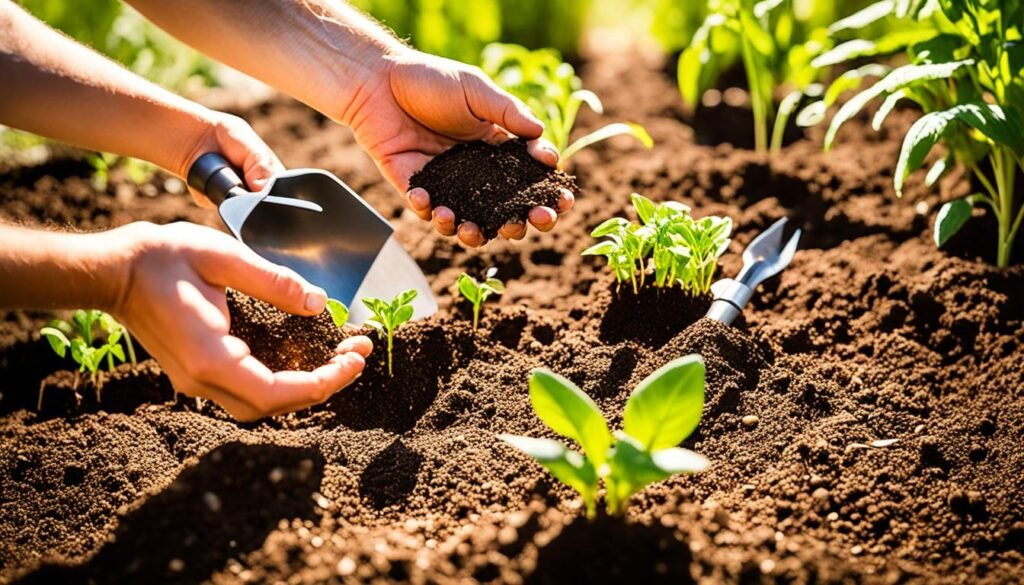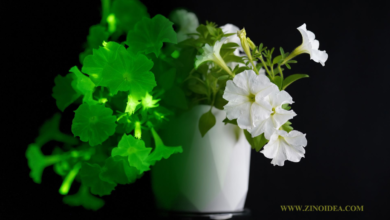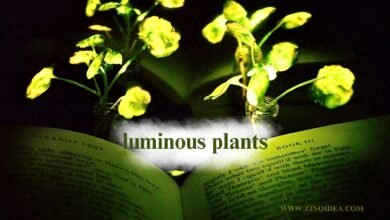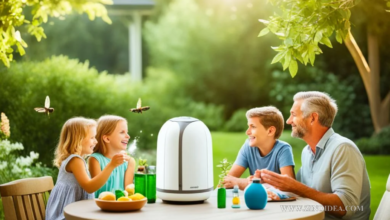Starting Your Dream Garden: A Beginner’s Guide

Have you ever thought about finding peace by working with the soil? Creating a garden that grows well and feeds the soul is possible. Starting your garden journey is a step towards personal growth and peace.
If you’re new to gardening, you’ll find that each seed you plant brings you closer to nature. Gardening might seem hard, but with the right help and attitude, you can make your outdoor area a lovely place. This guide will show you the basics of gardening, making it easy for beginners who love nature.

Key Takeaways
- Gardening offers emotional and therapeutic benefits.
- Connecting with nature can enhance well-being.
- Starting small is key for beginners.
- Choosing the right plants simplifies maintenance.
- Gardening can improve your home’s aesthetic appeal.
Understanding the Basics of Gardening
Gardening is both an art and a science. It combines different principles to grow plants well. Knowing these Gardening basics is key for beginners. Important factors include plant needs, soil types, and climate.
Photosynthesis is a key process. Plants turn sunlight into energy this way. Understanding plant biology helps in making better gardening choices.
Soil health is also vital. Healthy soil gives plants the nutrients they need. For beginners, testing soil type and pH levels is crucial. Adding organic matter to soil can make it richer and better structured.
Trying out different gardening styles is part of Gardening101. You can choose from raised beds, container gardening, or in-ground gardens. Each has its own benefits, helping gardeners pick what fits their space and likes.
| Gardening Style | Key Features | Best For |
|---|---|---|
| Raised Beds | Elevated soil, better drainage | Limited space, urban gardens |
| Container Gardening | Versatile, mobile options | Patios, small areas |
| In-Ground Gardening | Direct soil planting, larger scale | Traditional gardens, larger spaces |
The Benefits of Starting Your Own Garden
Starting a garden brings many Benefits of gardening for your health and the planet. It helps your mental health by lowering stress and anxiety. Being in nature makes you feel better and calmer.
It also boosts your physical health. You get to eat fresh, organic veggies right from your garden. This leads to better eating habits and knowing your food’s source.
Gardening is good for the environment too. It creates homes for many species, helping the ecosystem. It also cuts down on your carbon footprint.
Adding gardening to your life changes things for the better. It offers deep benefits for your health, happiness, and the planet.
| Benefit | Description |
|---|---|
| Mental Health | Gardening reduces stress and elevates mood by connecting individuals with nature. |
| Physical Health | Access to fresh produce leads to healthier eating and lifestyle choices. |
| Environmental Impact | Supports biodiversity and helps in reducing greenhouse gas emissions. |
| Community Engagement | Gardening can build community ties and encourage collaboration among neighbors. |
| Skill Development | Enhances skills like planning, patience, and care through ongoing gardening tasks. |
Choosing the Right Location for Your Garden
Finding the perfect Park location is crucial for a garden to flourish. The right spot can greatly affect your plants’ health. You should look at several key factors, including:
- Sunlight Exposure: Most plants need 6-8 hours of sunlight each day. Watch how the sun moves in your yard during the day.
- Accessibility: Make sure you can easily reach your garden for tasks like watering, weeding, and picking.
- Proximity to Water Sources: Being near a water source makes watering easier.
Some places might have problems like flooding or strong winds. It’s best to avoid these areas for gardening. Checking the soil is also important for a great garden. Do a soil test to see its pH and nutrient levels, which affect how well plants grow.
For a garden ready for planting, do the following:
- Remove any debris or weeds.
- Loosen the soil to help roots grow well.
- Make sure the soil drains well to prevent waterlogging.
How to Start a Garden: Essential Steps
Starting a garden takes careful planning and understanding. It’s important to know your space before you start. Look at the area you have and the soil quality. This helps make sure your garden can grow well.
Assess Your Space and Soil
When checking your space, think about sunlight, wind shelter, and water closeness. A soil test tells you about pH levels and nutrients. This helps you pick the right plants. You might find your soil needs something to make it better, which can help your garden grow.
Determine the Type of Garden You Want
Then, pick the garden type that fits your interests and goals. You could have a vegetable, flower, or herb garden. Each type needs different space, care, and resources. Think about what you like and what fits your space and life.

Essential Tools for Beginner Gardeners
Starting your gardening journey can be exciting and a bit overwhelming. Having the right tools makes it more fun and productive. Quality tools help you do tasks better and make you feel confident. Here are some must-have tools and accessories to get you started.
Must-Have Gardening Tools
Every beginner needs a set of basic tools for various gardening tasks. Here are some essentials:
- Trowel: Perfect for digging small holes and moving seedlings.
- Pruners: Needed for trimming plants and keeping them healthy.
- Gardening Gloves: Protects your hands from blisters and dirt.
- Watering Can: Helps plants get the right amount of water without overdoing it.
- Rake: Great for clearing debris and smoothing out the soil.
Helpful Accessories for Your Garden
There are also accessories that can make gardening better. These items make tasks easier and more fun, especially for beginners:
- Kneeling Pad: Keeps you comfortable while you plant and weed.
- Plant Markers: Helps you keep track of your plants and their progress.
- Garden Hose: Makes watering large areas easy.
- Compost Bin: Good for recycling and improving your soil.
Having the right tools and accessories is key to a great gardening experience. Invest in quality items that meet your needs. Enjoy the journey of growing beautiful plants and vegetables.
Planning Your Garden Layout
Starting with a good layout is key to a successful garden. It’s important to arrange spaces so plants get enough sunlight and air. A visual plan helps beginners see how different plants will fit together and grow well.
When planning your garden, think about these important points:
- Space Utilization: Use the space wisely by setting up different areas for different plants.
- Plant Spacing: Make sure plants are far enough apart to grow well and not fight over resources.
- Companion Planting: Pair plants that help each other out, like keeping pests away and boosting growth.
Here’s a table showing some great plant pairs that work well together, making the most of your space.
| Plant Type 1 | Plant Type 2 | Benefits |
|---|---|---|
| Tomatoes | Basil | Enhances flavor and repels pests |
| Carrots | Onions | Reduces pests that harm both plants |
| Corn | Beans | Beans fix nitrogen, benefiting corn |

By thinking about these points, you can make a garden that looks great and works well. Spending time on planning will lead to a garden that’s both beautiful and fun to maintain.
Choosing the Right Plants for Your Garden
Choosing the right plants is key to a successful garden. Knowing your garden’s conditions helps plants grow well. Climate, soil type, and sunlight are important for picking the right plants.
Factors to Consider When Selecting Plants
Think about these things before picking plants:
- Climate: Check if your area has hot summers, cold winters, or mild weather all year.
- Soil Type: Find out if your soil is sandy, clayey, or loamy to match it with plants.
- Sun Exposure: See how many hours of direct sunlight the area gets each day.
Ideas for Easy-to-Grow Plants
For beginners, here are some easy plants to grow:
| Plant Name | Sun Requirements | Water Needs | Growing Season |
|---|---|---|---|
| Tomatoes | Full Sun | Moderate | Summer |
| Basil | Full Sun | Moderate | Summer |
| Marigolds | Full Sun | Low | Spring to Fall |
| Zucchini | Full Sun | Moderate | Summer |
| Radishes | Partial to Full Sun | Low to Moderate | Spring to Fall |
Starting a Vegetable Garden from Scratch
Starting your own vegetable garden is both exciting and rewarding. To begin with بدء حديقة الخضروات, you need a clear plan. This ensures your plants grow healthy and produce well.
First, get your garden ready. Pick a spot that gets plenty of sun and has good drainage. Remove any weeds and add compost or organic stuff to the soil. This helps with drainage and gives your plants the nutrients they need.
Then, choose easy vegetables for beginners. Think about growing these simple ones:
- Tomatoes
- Radishes
- Carrots
- Leafy Greens (lettuce, spinach)
Once you’ve picked your plants, plan when to plant them. A simple table can guide you on the best planting times:
| Vegetable | Planting Season | Harvest Time |
|---|---|---|
| Tomatoes | Spring | Summer |
| Radishes | Spring/Fall | 4-6 weeks |
| Carrots | Spring | 2-3 months |
| Leafy Greens | Spring/Fall | 6-8 weeks |
Use crop rotation to keep your soil healthy. Change the types of vegetables you grow in different spots each year. This stops soil from getting worn out and keeps pests away. With regular care and watering, your garden will do great.
Watering and Maintenance Tips for New Gardens
Starting a new garden means learning about Garden maintenance and how to water plants right. It’s key to manage water well and keep up with maintenance for healthy plants. This part will cover how to figure out what your plants need and basic care tips.
Understanding Water Requirements
Each plant needs different amounts of water based on its type and where it grows. Knowing these needs early helps with plants irrigation. Look out for signs like yellow leaves or root rot for too much water. If leaves droop or soil feels dry, it might be getting too little water. Watching your plants closely helps you adjust their water schedule.
Basic Maintenance Practices for Healthier Plants
Keeping a garden healthy means doing regular tasks. Here are some important ones:
- Weeding: Take out weeds often to stop them from taking over and competing for water and nutrients.
- Mulching: Use mulch to keep the soil moist and stop weeds from growing.
- Pest monitoring: Look for pests and deal with them quickly.
Following these Garden maintenance tips will make your garden look better. It ensures your plants get the care they need to do well.
Exploring Gardening Techniques and Strategies
Understanding modern gardening techniques can greatly improve your gardening. These methods cater to various gardeners’ needs and likes. Organic gardening is a key technique that grows plants without synthetic chemicals. It’s good for health and the planet.
Permaculture is a top strategy for gardens. It combines land, resources, and the environment to boost biodiversity and resilience. By mimicking nature, gardeners can create thriving gardens that use fewer resources.
Vertical gardening is another modern way to garden. It uses space up high for plants to grow. Perfect for city gardens, it lets you grow many plants, including fruits and veggies, and looks good too.
Adding technology to gardening makes it more efficient and fun. For example, gardening apps give you tips for your plants. Soil moisture sensors check how much water plants need, preventing too much water.
The following table summarizes these techniques and their key attributes:
| Gardening Technique | Benefits | Best For |
|---|---|---|
| Organic Gardening | Reduces chemicals, improves soil health | Health-conscious gardeners |
| Permaculture | Promotes biodiversity, sustainability | Those interested in environmental stewardship |
| Vertical Gardening | Maximizes small spaces | Urban gardeners with limited space |
| Garden Technology | Enhances efficiency, saves time | Tech-savvy gardeners |
Cn :
Starting your garden journey is thrilling and full of possibilities. It’s a rewarding process that brings many benefits, like better mental health and more beautiful outdoor areas. Seeing your garden grow is a unique feeling that shows how every gardening pro started as a beginner.
When you begin your gardening path, remember that hard work and love are crucial. Think about the Gardening Abstract and Gardening tips from this guide and apply them to your garden. You can grow beautiful flowers, tasty vegetables, or both, with endless options.
Use this chance to learn and grow, not just your plants but also your bond with nature. Your garden can turn into a peaceful place, bringing you joy and calm for many years. So, pick up your gardening tools, plan your garden, and start your journey. It’s time to make your gardening dreams come true!
FAQ
How do I start a garden as a beginner?
To start a garden, first look at your space and pick a spot that gets enough sunlight. Learn the basics of gardening, like what soil and plants need. Use starter plants or seeds right for your area, and practice watering and weeding.
What are some tips for beginner gardening?
For beginners, start small to not feel too overwhelmed. Pick plants that are easy to grow. Use good tools to work better. Keeping a gardening journal helps you track your progress and learn from your gardening.
What tools do I need to start my first garden?
Beginners need a trowel, pruners, gloves, a watering can or hose, and a rake. As you get better, you might also need a shovel or garden fork for different tasks.
How can I choose the right plants for my garden?
Think about your local climate, soil, and sunlight when picking plants. Choose plants that fit your garden’s conditions. Look for easy-to-grow options that you like.
What are the benefits of starting a vegetable garden?
Starting a vegetable garden gives you fresh produce, boosts mental health, and makes you feel proud of your food. It supports a green lifestyle and beautifies your yard.
How do I know when to water my plants?
Check the soil’s moisture to know when to water. Water when the top inch feels dry. Watch out for over-watering signs like yellow leaves and wilting. Under-watering shows as dry, crispy leaves. Different plants need different amounts of water.
What are some easy-to-grow plants for beginners?
Beginners can grow tomatoes, radishes, lettuce, and herbs like basil and mint. These plants are easy and give quick results, perfect for new gardeners.
What is the best way to plan my garden layout?
Plan your garden by thinking about plant height, spacing, and light needs. Use companion planting to save space and fight pests. Make a diagram to see your layout before planting.
How often should I check my garden for pests?
Check your garden for pests once a week. Catching problems early helps you manage them better. Look for damage or unusual droppings and use safe pest control methods when needed.



